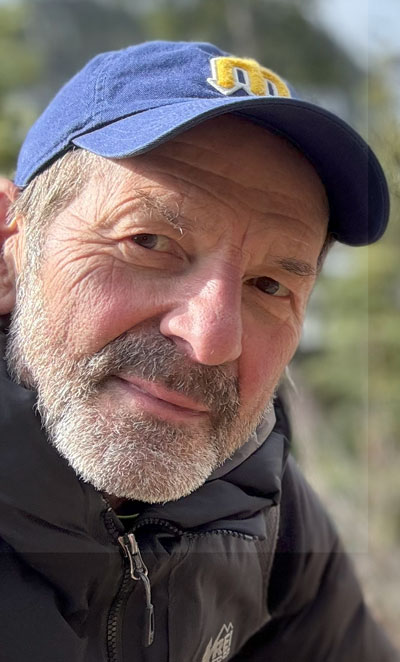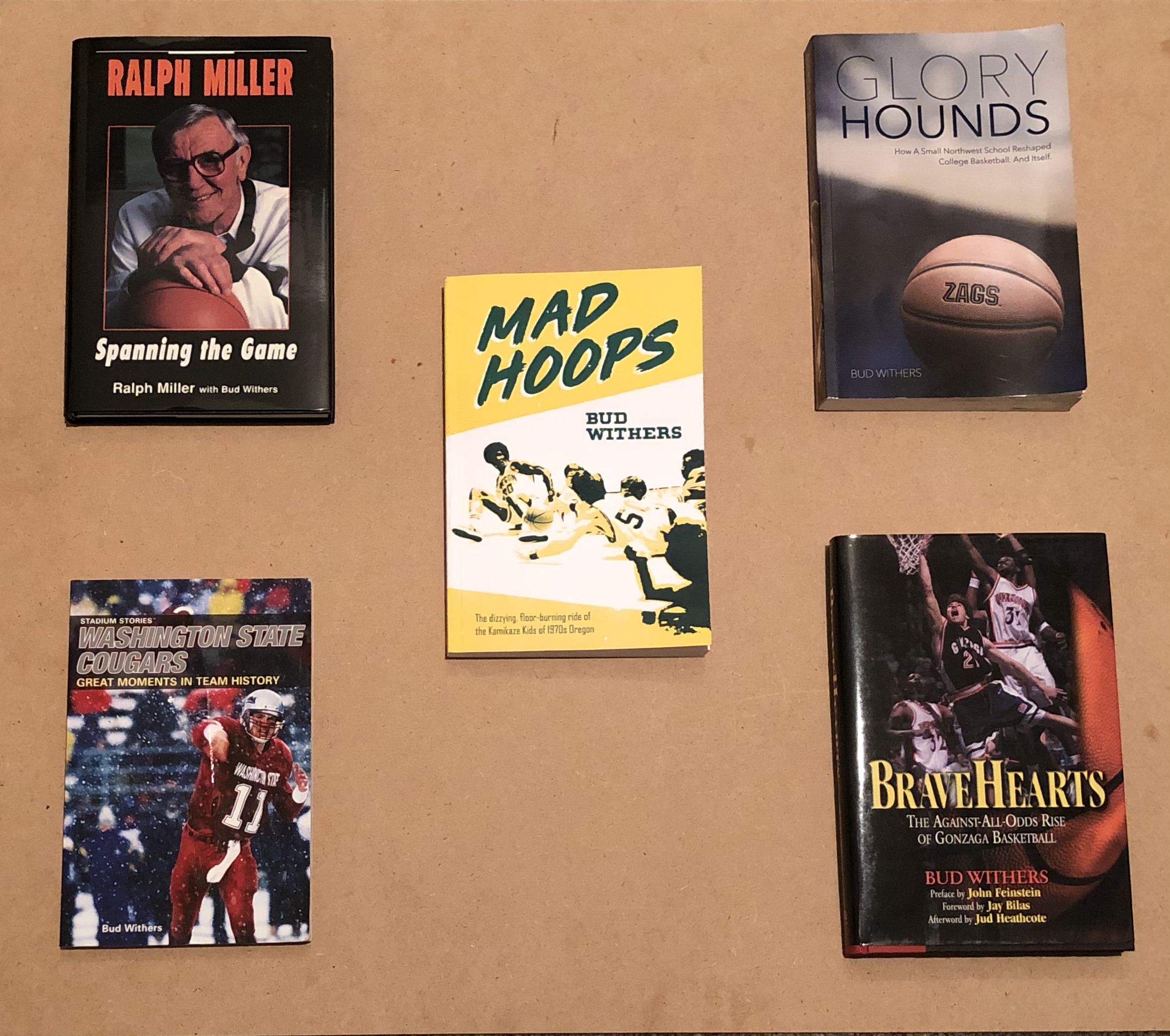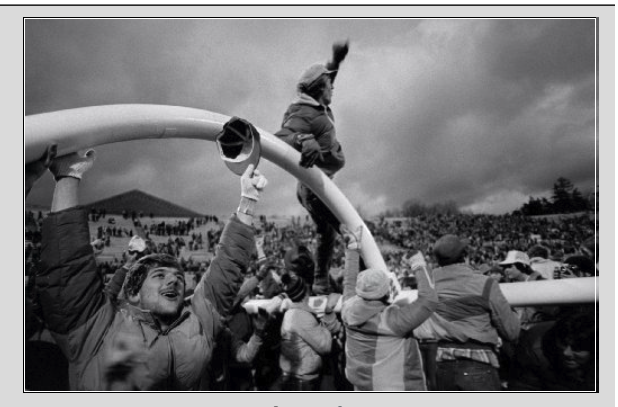About Bud
On June 8, 1970, Bud Withers labored into Eugene, driving a 1967 Mustang fastback belching hot radiator fluid. He had 49 cents in his pocket and a blank check of questionable solvency from his parents.
Two days later, he began a 17-year stint at the Eugene Register-Guard, the first of three major Northwest newspapers that employed him to write sports, chiefly on the colleges. The latest iteration of that writing jones is “Too Good to Be Through,” a look at the unique football rivalry between Washington and Washington State and the personalities that help make it so.
Bud worked at the Register-Guard until 1987, the last five years as the paper’s sports columnist. The football was mostly destitute – confirmed years later when he discovered in an Oregon media guide that the Ducks went – precisely – from 1970 to 1987 without being ranked. (He refuses to take any blame for that).
He went on to the Seattle Post-Intelligencer in 1987, and in more than 11 years by the waterfront, covered characters like Dennis Erickson, Mike Price and Kelvin Sampson at Washington State and Jim Lambright and Rick Neuheisel at Washington. In helping to chronicle the Mariners’ edgy existence of that era, Bud managed to duck ceiling tiles that fell from the Kingdome in 1994 and was there for the dizzying, franchise-saving 1995 playoff run against the Yankees.

In 1999, he joined the Seattle Times, eventually elevated to a role as a columnist weighing in on events surrounding the Pac-12 Conference. That brought him into the orbits, for better or worse, of people like Larry Scott and Mike Leach.
As dumbstruck as he was by the 2009 folding of his old paper, the Post-Intelligencer, Bud was figuratively flattened by the demise of the Pac-12 in 2023. Again, he cops to no culpability in either of those deaths.
Along the way, Bud has authored six books and was a contributor to ESPN’s 2005 College Football Encyclopedia. His latest work, “Too Good to Be Through,” looks at what he calls the nation’s most distinctive college-football rivalry, Washington versus Washington State, through the lens of fans and boosters who give the series its real juice.
Bud covered the 1984, 1988 and 1992 Summer Olympic Games; 20 college hoops Final Fours among the 73 NCAA-tournament weekends he staffed; and 31 Apple Cups. He has placed in multiple writing contests by several organizations, been named sportswriter of the year in both Oregon and Washington, and is a past president and hall-of-fame member of the U.S. Basketball Writers Assn.
Retired from daily newspapering in 2015, Bud lives in Woodinville, Washington with his wife Velvet and his John Deere rider mower.
Book writing history
Bud launched into book-writing in 1991 with a ghostwritten biography, “Spanning the Game,” of Oregon State’s Hall of Fame basketball coach, Ralph Miller, managing to survive both Miller’s legendary chain-smoking and a ridiculously ambitious three-week deadline. (He doesn’t recommend it.)
Next, in 2002, came a revelatory look at the Gonzaga basketball program with “BraveHearts.” Little did Bud – or anybody else – guess that the Zags’ burst onto the national scene would morph methodically into a quarter-century prominence in college hoops.
He followed in 2006 with one of a series of college-football books in “Washington State Cougars: Great Moments in Team History.”
|
The Huskies went down in the 1982 game, and so did the goal posts |
Shortly after retirement from a 45-year sportswriting career in the Northwest, Bud began exploring the realm of self-publishing, and that gave rise to his second book on the phenomenon of Gonzaga basketball, “Glory Hounds.” By now, the Zags had become as regular as the water bill, making the NCAA tournament without fail, doing damage and generally establishing themselves as a fixture in the college-basketball mosaic.
Having had a front-row seat to the loopy histrionics of Oregon basketball coach Dick Harter in the 1970s, Bud hatched a 2020 book on the Ducks’ so-called “Kamikaze Kids” of that era, retracing a regime that, because of Oregon’s limited success then – Harter was Bob Knight without the trophies – was relegated to the dustbin of college hoops history. But we shouldn’t overlook a coach who once tripped, intentionally, an opposing male cheerleader.

That brought Bud to “Too Good to Be Through,” an examination of the football rivalry between Washington and Washington State. It explores the annual Apple Cup joust, with the undulations of each program’s road map through 125 years. More than that, the book captures the color of the series, with a particular look at the relationships between Huskies and Cougars that fuel what Bud terms the most distinctive rivalry in the nation.
A book that can almost buy a drink legally
“Too Good to Be Through” has a long and tortured history, dating to a fuzzy date back in the 1990s when I was covering University of Washington football in the Jim Lambright era (1993-1998).
One day, a colleague mentioned idly that there was no book in existence on the history of the Apple Cup football rivalry. Having already written one book a few years earlier, I filed that notion away.
It was perhaps a decade later, about 2005, that I began what would be an extended (some might say procrastinated) campaign to research the Apple Cup, back to its roots in the year 1900. The idea was to flesh out details of every game in the series, mostly from newspaper accounts on microfilm. That took place chiefly at the University of Washington’s Suzzallo Library, but also at WSU’s Holland Library and elsewhere.
That was, at times, an eyeball-crunching exercise. I wanted not only to fetch game accounts, but to peruse several days’ events leading into them, to know the particular temperature for each meetup. As for the eyeballs, you haven’t lived until you’ve waded into the 37th paragraph of a 1907 game story on blurry microfilm to find out who scored the second UW touchdown.
In spare time, I did about a century’s worth of research and then tabled the project in about 2008. But I did claim the good sense to line up some interviews about that time from aging, key figures like former coaches Don James and Jim Sweeney.
After retiring from the Seattle Times in 2015, I launched into a couple of other books that seemed to command more prompt attention. Finally, a year after the Covid-19 pandemic in 2020, I decided that either I needed to resume relations with the book, or those voluminous pages of research would be nothing more than fire-starter.
I jumped back by interviewing as many key former Husky and Cougar players and coaches as I could; resumed the year-by-year study of the games; and tried to convey the lifeblood of the rivalry with anecdotes speaking to its color.
I can say this without equivocating: The book required easily the most research of any I’ve undertaken. In my experience, there had always been a finite end to the quest. I’m sure somebody out there tells a juicy story on the Apple Cup, and I missed it. It’s a wide, wide canvas.
I hope enough of those found their way into “Too Good to Be Through” to keep you entertained.
